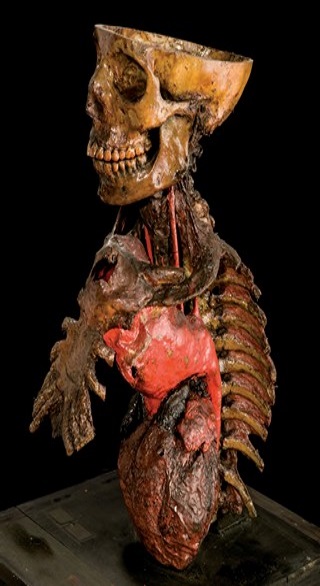Reperti di Anatomia Patologica
Apparato Cardiovascolare


Aneurisma sifilitico dell’aorta toracica
Busto tannizzato comprendente cranio, ossa toraciche, cuore e aorta. Si noti una erosione e perforazione dello sterno da aneurisma sacciforme dell’arco aortico.
Gli aneurismi luetici (detti anche aneurismi sifilitici) sono un tipo di aneurisma che si verifica normalmente in seguito ad aortite sifilitica.
L'aortite sifilitica è un'infiammazione dell'aorta associata allo stadio terziario dell'infezione da sifilide. La sifilide è un‘infezione sessualmente trasmessa (IST) causata dal batterio Treponema pallidum e nei casi di aneurismi correlati, l'aorta ascendente è più comunemente coinvolta. L'aortite sifilitica si verifica durante la fase della sifilide terziaria tra i 5 e i 30 anni dopo l'inizio della sifilide primaria.
Con il peggioramento dell'aortite sifilitica, il vasa vasorum subisce un ispessimento iperplastico delle pareti limitando così il flusso sanguigno e causando ischemia dei due terzi esterni della parete aortica. Se la malattia progredisce, l'aortite sifilitica porta a un aneurisma aortico.
L'incidenza delle manifestazioni tardive della sifilide è diminuita quasi fino a diventare molto rara a partire dall’introduzione degli antibiotici. Prima della scoperta della penicillina, l'infezione da sifilide terziaria era la causa più comune di aneurisma dell'aorta toracica, causando il 5-10% di decessi cardiovascolari.
Syphilitic aneurysm of the thoracic aorta
Tannized bust including the skull, the chest, the heart and the aorta. Note the sternal erosion with perforation and external rupture of a syphilitic saccular aneurysm.
Luetic aneurysms (also called syphilitic aneurysms) are a type of aneurysm occurring usually secondary to syphilitic aortitis.
Syphilitic aortitis is inflammation of the aorta associated with the tertiary stage of syphilis infection. The responsible organism is a spirochete Treponema pallidum and the ascending aorta is most commonly involved. Syphilitic aortitis takes place during the stage of tertiary syphilis between 5 to 30 years after initiation of primary syphilis.
As syphilitic aortitis worsens, the vasa vasorum undergo hyperplastic thickening of their walls thereby restricting blood flow and causing ischemia of the outer two-thirds of the aortic wall. If the disease progresses, syphilitic aortitis leads to an aortic aneurysm.
The incidence of late manifestations of syphilis have declined almost to a rare entity since the era of antibiotics. Before the discovery of penicillin, tertiary syphilis infection was the most common cause of thoracic aortic aneurysm, resulting in 5–10% of cardiovascular deaths.
References:
Paulo, N., Cascarejo, J., & Vouga, L. (2012). Syphilitic aneurysm of the ascending aorta. Interactive cardiovascular and thoracic surgery, 14(2), 223–225.
Stone, JR; Bruneval, P; Angelini, A; Bartoloni, G; Basso, C; et al. (2015). "Consensus statement on surgical pathology of the aorta from the Society for Cardiovascular Pathology and the Association for European Cardiovascular Pathology: I. Inflammatory diseases". Cardiovascular Pathology (Review). 24 (5): 267–78.
Zampieri F et al. (2013). Diego Rivera’s Fresco and the Case Taken From Morgagni’s De Sedibus. The American Journal of Cardiology.


